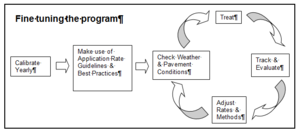
Evaluating the effectiveness for winter parking lot and sidewalk maintenance
Information: We are in the process of migrating the Winter Parking Lot and Sidewalk Maintenance manual to the Minnesota Stormwater Manual. You can access a pdf version of the maintenance manual here. Other changes and updates to information on salt management will be posted in the What's new page in the manual. Information on road salt and water quality can be found on MPCA's website
The following information is useful for evaluating the effectiveness of winter parking lot and sidewalk maintenance.
After the Storm
When snow and ice control operations have ended after the storm, evaluate what was done, what worked, and what could be changed to improve operations.
- Have an after-the-storm discussion with the maintenance crew.
- Have an after-the-storm discussion with the property manager.
- Consider the environmental impacts caused by deicer/abrasive use.
- Based on all aspects of the storm fighting experience, look for ways to improve practices.
- Clean and check all equipment.
- At the end of the season, clean and maintain the truck, tanks, brine-making systems, and pumps according to manufacturer specifications.
- Do not use deicers at the end of the season just to use them up. Save them for next year. Place all piles on an impervious pad and cover them. This includes salt and salt/sand mixes.
- If there is no place for year round storage, contact the city, they may be willing to purchase it, take it, or store it. Everyone benefits from good storage and less salt in our water.
Tip: Save extra salt at the end of the season. Do not apply just to get rid of it.
Documenting and charting
Good documentation leads to reduced use of materials, more effective snow and ice control, reduced environmental impacts, and cost savings.
- Without documention and charts, there is no measurement of performance.
- Track the material use. Learn to record what and how much is applied at each site, from each visit. Be prepared to analyze and make adjustments to the process based on what is learned.
- Use forms like those shown below to record and track the work and observations.
Anti-icing data form
Link to this table
| Location: | ||||
|---|---|---|---|---|
| Date: | ||||
| Air temperature | Pavement temperature | Relative humidity | Dewpoint | Sky - cloud cover |
| Reason for applying: | ||||
| Location: | ||||
| Chemical: | ||||
| Application Time: | ||||
| Application Amount | ||||
| Observation (after event): | ||||
| Observation (efore next event): | ||||
| Name: | ||||
Documentation form for deicing
Link to this table
| Operator: | |||
|---|---|---|---|
| Location: | |||
| Event Began: | Date | Time | |
| Event ended: | Date | Time | |
Event type:
|
|||
| Total precipitation: | |||
| Pavement temperature: | |||
| Air temperature: | |||
| Dew point:: | |||
| Temperature Trend: | |||
| Material used: | |||
| Amount used: | |||
| Application rate: | |||
| Observations: | |||
Information:  Following Best Practices and documenting actions will help prove the professional is doing the best job possible and may reduce liability.
Following Best Practices and documenting actions will help prove the professional is doing the best job possible and may reduce liability.
Related pages
- Background information for winter parking lot and sidewalk maintenance
- Preparing for winter operations for winter parking lot and sidewalk maintenance
- Keeping surfaces clear for winter parking lot and sidewalk maintenance
- Evaluating the effectiveness for winter parking lot and sidewalk maintenance
- Environmental tips for winter parking lot and sidewalk maintenance
- Cost savings tips for winter parking lot and sidewalk maintenance
- Results and evaluation for winter parking lot and sidewalk maintenance
- Material conversions for winter parking lot and sidewalk maintenance
- References for winter parking lot and sidewalk maintenance
- Additional resources and links to websites for winter parking lot and sidewalk maintenance
This page was last edited on 6 December 2022, at 23:47.
